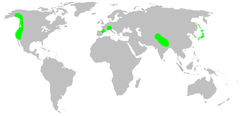Pimoidae
| Pimoidae | |
|---|---|
| Scientific classification | |
| Kingdom: | Animalia |
| Phylum: | Arthropoda |
| Subphylum: | Chelicerata |
| Class: | Arachnida |
| Order: | Araneae |
| Infraorder: | Araneomorphae |
| Family: | Pimoidae Wunderlich, 1986 |
| Diversity | |
| 4 genera, 42 species | |

| |
Pimoidae is a small family of araneomorph spiders first described by J. Wunderlich in 1986.[1] It contains 37 species in four genera and is monophyletic.[2] It is closely related to the Linyphiidae,[3] and is sometimes treated as synonymous with that family.[4]
The species Pimoa cthulhu, described by Gustavo Hormiga in 1994, is named for Howard Phillips Lovecraft's mythological deity Cthulhu.[3]
Distribution[]
Pimoidae forms a relictual group along the western coast of North America, Europe (Alps, Apennines and Cantabrian Mountains of northern Spain) and the Himalayas. This makes a holarctic predecessor probable. In 2003, a species was found in Japan.
Genera[]
As of April 2019, the World Spider Catalog accepts the following genera:[5]
Nanoa Hormiga, Buckle & Scharff, 2005
- Nanoa enana Hormiga, Buckle & Scharff, 2005 — USA
Putaoa Hormiga & Tu, 2008 — China
- Hormiga & Tu, 2008 — China
- (Xu & Li, 2007) — China
- Hormiga & Dimitrov, 2017 — Taiwan
Weintrauboa Hormiga, 2003 — China, Japan, Russia
- (Oi, 1979) — Japan
- (Karsch, 1881) — Russia, Japan
- (Saito, 1935) — Russia, Japan
- Xu & Li, 2009 — China
- Xu & Li, 2009 — China
- Hormiga, 2008 — China
- Yang, Zhu & Song, 2006 — China
Pimoa Chamberlin & Ivie, 1943 — North America, Asia, Europe
- Pimoa altioculata (Keyserling, 1886) — USA, Canada
- Hormiga, 1994 — China
- (Fage, 1931) — Spain
- Chamberlin & Ivie, 1943 — USA
- Xu & Li, 2007 — China
- (Fage, 1946) — India
- Pimoa cthulhu Hormiga, 1994 — USA
- Chamberlin & Ivie, 1943 — USA
- Mammola, Hormiga & Isaia, 2016 — Italy
- Hormiga, 1994 — USA
- Hormiga, 1994 — India
- Mammola, Hormiga & Isaia, 2016 — Italy, France
- Chamberlin & Ivie, 1943 — USA
- (Gertsch & Ivie, 1936) — USA
- Hormiga, 1994 — India
- (Gertsch & Ivie, 1936) — USA
- Xu & Li, 2009 — China
- Hormiga, 1994 — USA
- Griswold, Long & Hormiga, 1999 — China
- Hormiga, 1994 — USA
- Hormiga, 1994 — USA
- Hormiga, 1994 — Nepal
- ' Hormiga, 1994 — USA
- Xu & Li, 2007 — China
- Pimoa rupicola (Simon, 1884) — France, Italy
- Hormiga, 1994 — Nepal
- Hormiga & Lew, 2014 — USA
- Trotta, 2009 — India
- Xu & Li, 2007 — China
- Gertsch, 1951 — USA
See also[]
References[]
- ^ Wunderlich, J. (1986). Spinnenfauna gestern und heute: Fossile Spinnen in Bernstein und ihre heute lebenden Verwandten.
- ^ Hormiga, Gustavo (2003). "Weintrauboa, a new genus of pimoid spiders from Japan and adjacent islands, with comments on the monophyly and diagnosis of the family Pimoidae and the genus Pimoa (Araneoidea, Araneae)" (PDF). Zoological Journal of the Linnean Society. 139 (2): 261–281. doi:10.1046/j.1096-3642.2003.00072.x.
- ^ Jump up to: a b Hormiga, Gustavo (1994). "A Revision and Cladistic Analysis of the Spider Family Pimoidae (Araneoidea: Araneae)". Smithsonian Contributions to Zoology. 549: 533–542.
- ^ Murphy, J. A.; Roberts, M. J. (2015). Spider families of the world and their spinnerets. British Arachnological Society. ISBN 978-0950009377.
- ^ "Family: Pimoidae Wunderlich, 1986". World Spider Catalog. Natural History Museum Bern. Retrieved 2019-04-23.
Resource Links[]
- Pimoidae : Pimoidae page on Tree of Life Web Project.
| Wikispecies has information related to Pimoidae. |
- Pimoidae
- Araneomorphae families
- Araneomorphae stubs